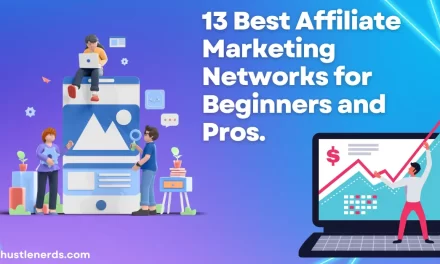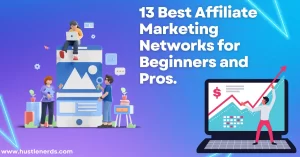
What Is Affiliate Marketing? : How To Succeed In 2025.

Table of Contents
What is Affiliate Marketing?
Affiliate marketing has emerged as a promising side hustle for many individuals who want to earn extra income without quitting their day jobs. It is a commission-based model in which affiliates promote and market other people’s products or services.

With the vast reach of the internet, affiliate marketing has become an excellent opportunity for anyone to earn significant income by leveraging their online presence and promoting products that align with their interests or niche.
What’s even more exciting is that the affiliate marketing industry is booming, with a predicted global revenue of $14.3 billion in 2023 and $15.7 billion by 2024, according to Influencer Marketing Hub’s affiliate marketing report.
There are two main reasons why we consider starting affiliate marketing is worth it.
The first one is that, unlike other businesses, starting affiliate marketing is less costly and risky because all you need to do is create a website or a domain.
Secondly, affiliate marketing makes it easier to scale and grow your business fast because, as an affiliate marketer, you can promote products or services from many different companies and earn a commission from all of them, unlike a typical salesperson who only sells products or services from one company.
This blog post aims to introduce you to the world of affiliate marketing and highlight some of the benefits you can expect from it.
How does affiliate marketing work
To truly grasp the concept behind affiliate marketing, it’s crucial to understand its fundamental components.
First, we have the Merchant. These are the people behind the product; they could be individuals or major corporations responsible for creating and selling the product.
Next, we have the Affiliate Marketer, also known as the Publisher. The critical role of an affiliate marketer is to guide their audience towards taking action, such as making a purchase, submitting a form, or visiting a specific website. This is achieved by incorporating affiliate links into their websites, blogs, or social media posts.
Then, we have the consumer, who buys the product. When a sale is made, the affiliate earns a commission based on this transaction.
To facilitate the process, we have an affiliate network. This acts as an intermediary between the affiliate and the merchant. It offers a database of products for affiliates to promote. Take Amazon, for example, the largest affiliate network for consumer goods, through their Amazon Associates program, with over 900,000 affiliates globally.
The affiliate network serves as the bridge connecting merchants and affiliates. The merchant provides the affiliate with a unique affiliate link that tracks any sales made through that specific link. The affiliate then promotes the merchant’s products or services to their audience using this personalized link. The affiliate earns a commission every time a sale is made through their link.
What are the types of affiliate marketing
Affiliate marketing was categorized into three types by renowned affiliate marketer Pat Flynn in 2009. The three categories are based upon whether an affiliate marketer has used the product he or she is promoting or whether they are in it only for the money. The three categories are further discussed below.
Unattached Affiliate Marketing
The first of the three categories is unattached or “blind” affiliate marketing. This approach involves promoting products that you have no personal connection to. In other words, you can profit by advertising products you have never used or seen before. Although this type of marketing can seem daunting, it’s particularly appealing as it requires no product expertise or customer support skills. Instead, you can use pay-per-click (PPC) campaigns to promote your affiliate link and collect commissions. It’s a low-commitment option that might suit those looking to test the waters without investing in a product or building customer relationships.
Involved Affiliate Marketing
The second of the three categories is Involved affiliate marketing, which, as the name suggests, is all about being closely tied to the product or service you’re promoting. Unlike unattached affiliate marketing, it goes beyond merely relying on pay-per-click(PPC). Instead, it revolves around personal experiences and building trust with your audience.
Here’s how it works: as an involved affiliate marketer, you try the product yourself first, which allows you to endorse it and authentically claim its use. This level of involvement and trustworthiness makes customers more inclined to believe your recommendations and view you as a reliable source of information.
This type of affiliate marketing requires more effort and time to establish credibility and build an Audience. However, the potential payoffs in the long run make it well worth the investment.
Related Affiliate Marketing
The third of the three categories is “related affiliate marketing.” In this type of marketing, affiliates leverage their relationships with their niche audiences to promote products they may not necessarily use. The most common example of related affiliate marketing is seen with influencers, who promote products without ever having tried them, for example, a fashion blogger promoting a clothing brand or an Affiliate promoting basketball shoes without ever having to wear them to play basketball since he or she has built a considerable following with website blogs or social media.
The main advantage of this form of marketing is that affiliates have unique expertise in generating traffic. However, the downside is potentially losing your audience’s trust if the promoted product or service is subpar.
HOW AFFILIATE MARKETERS GET PAID
Affiliate marketers get paid in various ways for their efforts to promote the products of merchants or product developers. There are various payment models that affiliate programs use to determine how affiliates receive payment for their efforts. Some of these models include price models, payout models, and conversion types, to name a few. Typically, the most popular payment model in affiliate marketing is the last-click marketing attribution, where the affiliate who receives the last click before a purchase gets 100% credit. However, this model is becoming outdated as attribution models that allow shared credit across multiple affiliates are gaining popularity. Thus, affiliate marketers can get paid by contributing to the buyer’s conversion funnel.

Some of the ways affiliates get paid include:
PAY PER SALE
This is a payment method in which the affiliate marketer gets paid or receives a commission for a sale. It is most familiar with e-commerce sales.
PAY PER ACTION/CLICK
This method allows affiliates to earn a commission when a consumer takes a specific action. Examples of actions include signing up for a newsletter, clicking a link, or submitting a contact form. This model is popular because it’s versatile and can be customized to fit the company’s needs.
There are two common concepts in pay per click, they are: Cost per Acquisition(CPA) and Earnings per click (EPC)
PAY PER INSTALL
In this payment method, the affiliate gets paid for directing a user or a consumer to the merchant’s website, where the user installs either an app or software. To get paid, the affiliate aims to promote the app or software for people to download and install.
PAY PER LEAD
The pay-per-lead model compensates affiliates based on lead conversion. To get paid, the affiliate has to persuade or convince the lead to visit the merchant’s website and complete a desired action, such as signing up for a product trial or a newsletter.
Tips to help you succeed in affiliate marketing.
Build a strong relationship with your audience.
Building strong relationships is key to affiliate marketing success. Stay in the loop with the brands you promote by keeping up with their latest developments, products, and initiatives. This way, you can provide your audience with accurate and up-to-date information about products of their interest. Your audience will love you for this, and in the long run, this can help you achieve success much faster than most of your competitors.
Build your expertise in a specific area or Niche.
To succeed in affiliate marketing, the secret lies in targeting a specific niche! Forget scattering your promotions and start focusing on a passionate audience. Position yourself as the go-to expert in one area rather than a jack of all trades. By becoming an authoritative figure in a specific area, you’ll put yourself before the people most likely to buy and have a greater chance of converting your leads.

Review products and services in your niche.
To truly succeed in affiliate marketing, it’s essential to immerse yourself in the review of products and services that align with your niche. Whether you’re promoting physical goods, digital tools, or specialized services, take the time to understand every detail about what you’re offering. The more knowledgeable you are, the more confidently you can position yourself as an expert.

Use this expertise to build trust with your audience through honest, in-depth reviews highlighting the key benefits they can expect. Be transparent about how these products or services can solve their problems or improve their lives. By fostering this level of confidence and connection, you’ll significantly increase your audience’s likelihood of acting on your recommendations.
Utilize various marketing strategies.
There are countless ways to promote products as an affiliate marketer. Don’t limit yourself to just one or two strategies; instead, utilize a variety of tactics such as email marketing, social media advertising, content marketing, influencer collaborations, and more. Each strategy has its own unique benefits and can reach different target audiences, increasing your chances of success.
Stay up-to-date with industry trends.
The world of affiliate marketing is constantly evolving, and it’s crucial to stay updated with the latest trends and changes in the industry. This will help you adapt your strategies accordingly and stay ahead of your competition. Follow industry blogs, attend conferences and webinars, and connect with other affiliate marketers to stay informed and continue learning.
Build a strong brand identity.
A strong brand identity is essential in any marketing, including affiliate marketing. It helps establish credibility and trust with your audience, making it more likely that they will take action on your recommendations.
Build an email list
An affiliate marketer’s email list is one of the most valuable assets. By consistently providing value and building a relationship with your subscribers, you can nurture and sell products or services to them over time. This can lead to a higher conversion rate as your audience has already shown interest in your content. One of the tricks you could use is to offer a free resource or service in exchange for visitors’ email addresses. Then, you can send them regular updates, promotions, and other content directly to their inbox.
Research potential affiliate programs
Not all affiliate programs are created equal, so researching and choosing the right ones for your niche is crucial. Look for programs that offer high commissions, have a good reputation, and align with your brand values. You could also reach out to other affiliate marketers or join online communities to get recommendations on which programs are worth joining. Don’t be afraid to test different programs and see what works best for your audience.
Disclose your affiliate relationships.
Being transparent about your affiliate relationships is essential for building trust with your audience. Make sure to disclose that you are an affiliate and include a clear disclaimer on your website or your content so readers know of potential bias. This not only helps maintain ethical standards but can also improve the credibility of your recommendations.
Conclusion
In conclusion, thriving in the dynamic field of affiliate marketing requires a combination of expertise, versatility, industry knowledge, and strong branding. Demonstrating your knowledge, exploring various marketing channels, staying up-to-date with industry trends, and establishing a strong brand identity can foster trust with your audience and boost your affiliate marketing success. Remember, it’s not just about selling but providing value to your audience, ultimately leading to a sustainable and profitable affiliate marketing business. So, keep learning, adapting, and growing to achieve long-term success in this ever-changing industry. Lastly, don’t forget to put in a bit of hard work in your side hustle, for, like most things worthwhile in life, succeeding in affiliate marketing needs effort.
Frequently Asked Questions
What is affiliate marketing, and how does it work?
Affiliate marketing is a performance-based marketing strategy in which an individual (the affiliate) earns a commission by promoting and driving sales or leads for a company’s products or services. It relies on a revenue-sharing model where affiliates are rewarded for promoting the company’s offerings and generating conversions. How Affiliate Marketing Works:
Join an Affiliate Program
Promote the Product or Service
Drive Traffic
Track Performance
Earn Commissions
How do I start affiliate marketing?
Starting affiliate marketing involves several steps, from choosing a niche to promoting products and tracking your performance. Here’s a step-by-step guide to help you get started:
Step 1: Choose a Niche
Pick a niche that you are passionate about or knowledgeable about. This will make it easier to create content and establish credibility. Furthermore, Analyze the demand and competition in your chosen niche.
Step 2: Select Affiliate Programs
Look for affiliate programs that offer products or services aligned with your niche. Popular platforms include Amazon Associates, ShareASale, ClickBank, and CJ Affiliate.
Step 3: Build a Platform
Build a platform to host your blog and promote affiliate products. Set up your site using WordPress or other website builders.
Step 4: Generate Content
Create valuable content that addresses the needs and interests of your target audience. This could include blog posts, product reviews, tutorials, and comparison guides.
Step 5: Drive Traffic
Optimize your content with relevant keywords to improve your search engine rankings and attract organic traffic.
Step 6: Track and Optimize
Use tools like Google Analytics to monitor your website traffic, user behavior, and conversion rates. Continuously experiment and refine your strategies based on data and insights to improve your results.
Step 7: Scale Your Efforts
Create more content targeting different keywords and topics within your niche. Explore additional traffic sources such as guest blogging, collaborations, and influencer partnerships, and consider joining additional affiliate programs to diversify your income streams.
Some of the tools and resources you may require include;
Keyword Research: Ubersuggest, SEMrush, Ahrefs.
Content Management: WordPress, Elementor, Canva.
Analytics: Google Analytics, Clicky.
SEO: Yoast SEO, Rank Math.
Email Marketing: Mailchimp, ConvertKit, AWeber
For more coverage on how to start Affiliate marketing, you can read our blog here on how to start Affiliate Marketing.
How do I earn in affiliate marketing?
Earning in affiliate marketing involves several steps, from selecting the right products to promoting them effectively and optimizing your strategies. Furthermore, it requires strategic planning, consistent effort, and ongoing optimization. By choosing the right niche, selecting profitable programs, building a strong platform, creating valuable content, driving traffic, and continuously refining your approach, you can build a successful affiliate marketing business and generate significant income.
How to learn affiliate marketing for beginners?
There are various ways for beginners to learn affiliate marketing, including online Affiliate marketing courses, webinars, mentorship programs, and self-study. Some of the best Affiliate marketing Courses we have reviewed include:
The Authority site system (TASS): An online course that teaches beginners how to create and monetize a successful authority website through affiliate marketing.
The Affiliate Lab by Matt Diggity: An extensive course for advanced affiliate marketers looking to scale their businesses.
Powerhouse Affiliate Academy: A comprehensive program that covers all aspects of affiliate marketing, from beginner to advanced level.
Passive Income Geek by Morten Storgaard: A course that teaches beginners how to earn passive income through affiliate marketing.
How can I start affiliate marketing with no money?
Starting affiliate marketing with no money is possible, though it requires creativity, effort, and strategic use of free resources. Here’s a step-by-step guide to help you get started There are various ways to start affiliate marketing with no money, such as:
Joining free affiliate programs: Many companies offer free affiliate programs you can join without any upfront costs. These programs allow you to promote their products or services and earn a commission for each sale.
Creating a blog or website: You can start a blog or website for free using platforms like WordPress or Wix. This will serve as your platform to promote affiliate products and generate income.
Promoting through social media: Social media platforms like Instagram, Facebook, and YouTube can be powerful tools for promoting affiliate products without spending money.
Utilizing SEO techniques: By learning about search engine optimization (SEO), you can drive organic traffic to your affiliate website or blog without spending money on advertising.
Networking and forming partnerships: Networking with other affiliate marketers or businesses in your niche can open up opportunities for collaboration and promotion without any financial investment.
You can build a successful affiliate marketing business with dedication and consistency without any initial investment.
Can I do affiliate marketing on mobile?
Yes, affiliate marketing can also be done on mobile devices. With the rise of smartphones and mobile internet usage, more and more people are accessing the internet through their phones. This presents a huge opportunity for affiliate marketers to reach a wider audience and promote products or services through mobile platforms.
There are various ways to do affiliate marketing on mobile, such as:
Social media promotions: As mentioned earlier, social media platforms like Instagram, Facebook, and YouTube can be powerful tools for promoting affiliate products. These platforms have user-friendly interfaces that make creating content easy and engaging with your audience.
Mobile-friendly websites: Make sure your affiliate website is optimized for mobile viewing. This means having a responsive design that adapts to different screen sizes and loads quickly on mobile devices.
Apps: You can also promote affiliate products through mobile apps. If you have a popular app, you can integrate affiliate links or ads within the app to earn income from user clicks or purchases.
Mobile advertising: Many advertising platforms offer options to target mobile users specifically. By utilizing these options, you can reach potential customers browsing on their phones and direct them to your affiliate offers.
Affiliate marketing on mobile may require some adjustments and strategies specific to the platform, but it can be a lucrative way to earn income and reach a wider audience. It’s essential to keep up with the latest mobile trends and adapt your marketing strategies accordingly. Attention spans and are more likely
How much can a beginner affiliate make?
A beginner’s earnings in affiliate marketing can vary widely based on several factors, including the niche selected, the effort put into content creation and promotion, the quality of traffic, and the affiliate programs chosen. While it’s challenging to provide a specific number, here are some general insights to help set realistic expectations:
Potential Earnings for Beginners
Initial Phase (First 3-6 Months):
Minimal Earnings: It’s common for beginners to earn between $0 and $100 monthly initially. This period involves a lot of learning, setting up platforms, creating content, and starting to drive traffic.
Growth Phase (6-12 Months):
Building Momentum: Earnings can increase to $200-$500 per month as you become more skilled and optimize your efforts. At this stage, you may start seeing more consistent traffic and conversions.
Established Phase (1 Year and Beyond):
Steady Income: With continuous effort and optimization, many affiliates can reach $1,000-$2,000 monthly. Depending on their niche and strategies, some may even surpass these figures.























Recent Comments